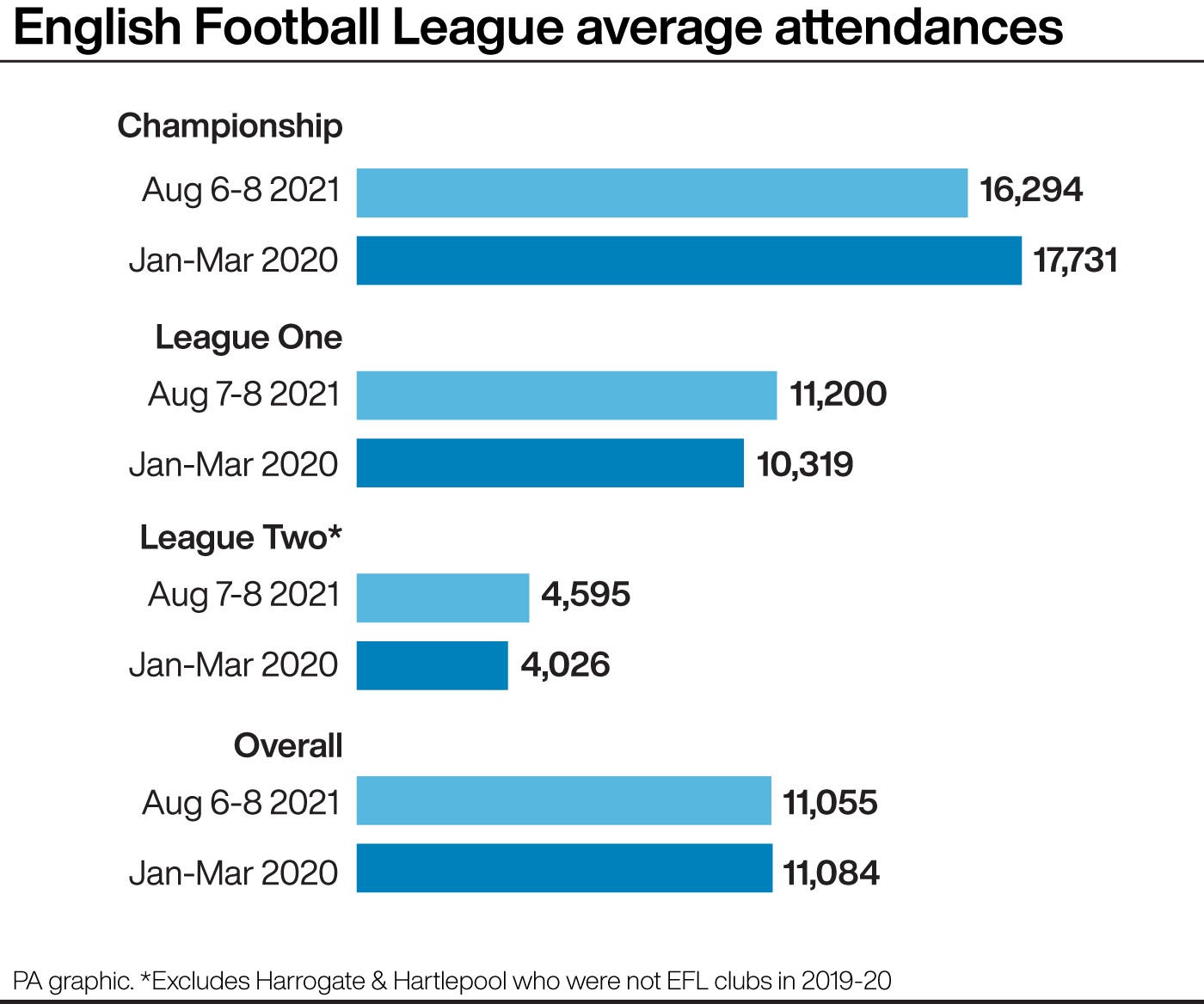Attendance boost for lower-league clubs at start of new season
Coronavirus did not deter fans from attending matches in Leagues One and Two over the weekend, with crowds up overall in each division compared to the average for the 2019/20 season.
Data gathered by the PA news agency showed modest increases in the third and fourth tiers of English football, though there was a drop at Championship level.
The average attendance in League One was up by almost 1,000 overall compared to the average among the weekend’s home clubs in 2019/20 – 11,200 compared to 10,319.
The total in League Two was up by more than 500 – 4,595 compared to 4,026. That figure excluded Harrogate and Hartlepool, who were in the National League in 2019/20.
The figures will be a boost to lower-league clubs, who generally rely more heavily on matchday revenue than those in the Premier League and the Championship and were therefore hit hardest by being forced to play the entire campaign behind closed doors in some cases last season.
The average second-tier attendance in the first round of Championship games was 16,294, 1,437 lower than the combined average for the clubs playing at home in the 2019/20 season.
The biggest increase was at Coventry – where almost 13,000 more people attended the match against Nottingham Forest on Sunday compared to the 2019/20 season average. However, the club have been promoted to the Championship since then and returned to the Ricoh Arena, having played their ‘home’ matches at Birmingham for the last two seasons.
The biggest drop was at Derby with the crowd of 16,249 for their match against Huddersfield over 10,000 down on their average home attendance in 2019/20 – 27,119.
One of the big increases in League One was at Bolton where a crowd of 16,087 for the visit of MK Dons was almost 4,000 up on the 2019/20 season average of 12,171.
Ipswich were up by 2,256, Sunderland by 1,408 and Fleetwood by 1,334.
Carlisle and Mansfield registered the biggest increases in League Two compared to their 2019/20 season averages – 2,484 and 1,689 respectively.
Malcolm Clarke, the chair of the Football Supporters’ Association, told the PA news agency: “August attendances are quite often a little down on the average for a season as a whole because of holidays, so if clubs are getting increases of 1,000 or 2,000 it suggests there’s a certain amount of enthusiasm for returning which is obviously a good thing.
“In general terms, fans that we’re aware of are very pleased to be back but there is a recognition that public health – not just of football fans but the people they might mix with – has got to be the most important factor.”
The Government swept away restrictions on capacity limits on 19 July, and these are now decided at local level.
There remains uncertainty over whether so-called ‘vaccine passports’ might be introduced – either across the board or at venues holding 20,000 or more spectators – from the end of September.
The key message from us is for all the Cs – clear communication and consultation about how it works in practice. If clubs do that I think fans will understand.
So far, only Chelsea among the 92 Premier League and Football League clubs have said they will insist on proof of vaccination or a recent negative test to gain entry to matches this season.
Clarke says the FSA membership has a broad range of opinions on whether such a scheme is the right way to go, but says the most important thing is a clear, rational approach.
“Speaking to the leagues, I get the impression they are a little bit frustrated that there hasn’t been central guidance on this on what measures are appropriate,” he said.
“The result of that is that local safety advisory groups, advised by their local directors of public health, seem to be taking some different views in different areas. Where that’s justified by higher infection rates, that’s fully understandable and you might expect the measures taken are a bit more stringent. But where it’s not, it feels a bit arbitrary.
“If fans feel that a decision to do a particular procedure at a ground that isn’t being done at a different ground can’t be explained by infection rates then they’re likely to get a bit annoyed and frustrated by it.
“The key message from us is for all the Cs – clear communication and consultation about how it works in practice. If clubs do that I think fans will understand. It’s a problem for all of us, and we’re all on the same page.”
Source: Read Full Article

